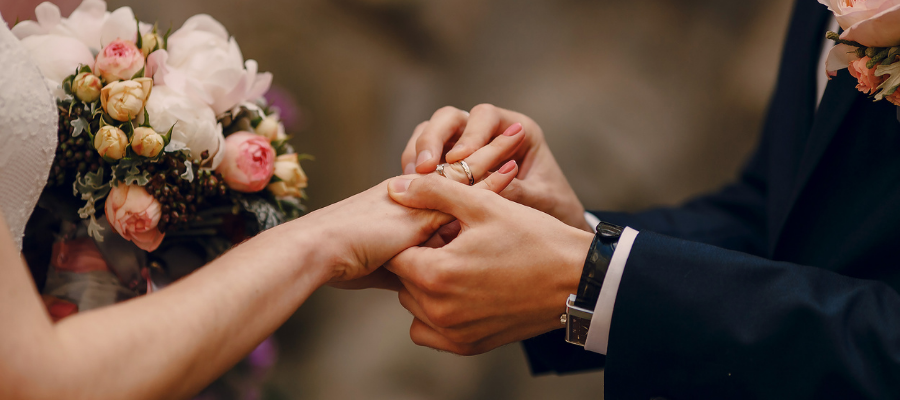The One Finger That Says “Forever”

Ever noticed that nearly everyone wears their wedding ring on the fourth finger? Not the thumb, not the pointer, the fourth. It's so ingrained in tradition we rarely question it. But there's a fascinating history (and a touch of myth) behind this quiet symbol of commitment. At WeddingRings.co.uk, we believe that every band tells a story, and this one starts long before modern wedding trends.


A LOVE STORY ROOTED IN THE VEIN OF LOVE
Let’s rewind to ancient Egypt. These early romantics believed that a vein called the vena amoris ran directly from the fourth finger of the left hand to the heart. Sounds like something straight out of a love poem, doesn’t it?
The Romans ran with the idea, and it quickly became customary to wear a ring on that finger during betrothals and weddings. While science has since proven the vein doesn’t actually exist, the symbolism stuck. And why not? Linking your ring finger to your heart adds a beautiful, poetic weight to something already deeply emotional.
So every time you slip that ring on, you’re not just marking your marriage. You’re echoing a belief thousands of years old: that love lives in the heart, and the fourth finger is its direct line.
HOW TRADITION TOOK HOLD
The tradition traveled, adapted, and evolved. In medieval Europe, rings were placed on three fingers to represent the Holy Trinity before settling on the fourth. By the 17th century, England had fully embraced the ring finger, thanks in part to King Edward VI standardising it with a decree. In short, it became the one.
Since then, the left-hand ring finger has become the international go-to. Cultural momentum built up over centuries, and as couples saw their parents, grandparents, and communities follow the same ritual, it became second nature.
And that's exactly how timeless traditions are born.


LEFT OR RIGHT? IT DEPENDS WHERE YOU ARE
While the left-hand ring finger is the standard in the UK, the US, Canada, and most Western countries, it’s not universal.
In Spain, Germany, Russia, Greece, and India, the right hand is traditional. In Jewish weddings, the ring is often placed on the right index finger during the ceremony, then moved to the left. Some couples switch the ring’s placement after the wedding, symbolising the transition from engagement to marriage.
These variations add depth and individuality to the tradition. Whether it's left or right, what matters is the meaning behind it. Your ring is a symbol of a bond, not a rulebook.
SYMBOLISM MEETS PRACTICALITY
Beyond tradition and poetry, there's also a practical reason the fourth finger wins out.
It’s generally on the non-dominant hand, which means less wear and tear. It’s less likely to interfere with everyday tasks compared to the thumb or index finger. And let's be honest, it just looks balanced and elegant there.
The fourth finger has the perfect mix of visibility and subtlety. It shows you're taken, without being flashy. It's a quiet commitment, always in view, always near your heart.
WHAT IT MEANS FOR YOUR WEDDING RING
At WeddingRings.co.uk, we design our rings with this tradition in mind. Whether you're going for classic yellow gold, modern platinum, or something bespoke and personal, every ring is made to sit perfectly on that all-important finger.
Our bands are comfortable enough for everyday wear, secure enough to last a lifetime, and crafted to honor the stories they represent.
We even offer a free ring sizer because comfort on the ring finger matters just as much as style.


HOW TO MAKE THE TRADITION YOUR OWN
Here’s a simple trick. Every time you glance at your ring finger, imagine the invisible thread tying it to your heart. That’s not just history, it’s your story now.
A few ways to make the tradition your own:
- Engrave a secret message on the inside, just for you two
- Choose matching metals with distinct finishes, showing unity with individuality
- Design your band to echo your partner’s style, creating a subtle connection between both hands
In a world full of trends, this one tradition holds its ground. And it’s not going anywhere.
The fourth finger tradition isn't just about habit. It’s about meaning. From ancient beliefs to modern commitments, this small detail carries centuries of love, symbolism, and beauty. It's where your love story lives, one glance at a time.
So when you’re ready to choose a wedding ring, make sure it’s one that belongs there. Not just in size, but in spirit. Discover yours at WeddingRings.co.uk
Browse timeless designs, explore our bespoke options, or get in touch for a custom creation. Because your ring finger deserves more than a band - it deserves a legacy.







